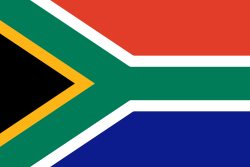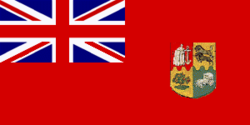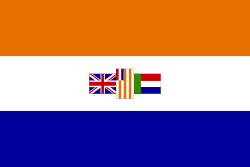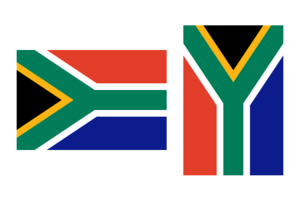Flag of South Africa
2007 Schools Wikipedia Selection. Related subjects: General Geography
The current design of the National Flag of the Republic of South Africa was adopted on 27 April 1994, the end of apartheid prompting the widespread conviction that a new national flag must include the cultures of all South Africans.
None of the flag designs submitted by the public was supported by the committee charged to select the final design. An interim flag was designed by State Herald Frederick G. Brownell for the 27 April elections, the nation's first fully inclusive elections, and for Nelson Mandela's May 10 inauguration. The flag was so well received that the interim version was made the final, national flag in the South African Constitution. Given the troubled historical context, it is remarkable that a consensual replacement for the former national flags was found. The new flag is seen as an enduring symbol of the modern South African state.
A heraldic description of the flag would be something like "per pall fesswise gules, sable and azure, a fesswise pall vert fimbriated argent, Or and argent". In plain English, this means two equal width horizontal bands of red (top) and blue separated by a central green band which splits into a horizontal Y, the arms of which end at the corners of the hoist side (and follow the flag's diagonals). The Y embraces a black isosceles triangle from which the arms are separated by narrow yellow bands; the red and blue bands are separated from the green band and its arms by narrow white stripes. The stripes at the fly end are in the 5:1:3:1:5 ratio. The South African flag is the only six-coloured national flag in the world without a seal or brocade.
Design
When the new flag was designed, it was specifically stated that the colours had no official meaning or symbolism, other than their choice from their use in the past. However, according to Brownell, the flag's designer, the red symbolises the blood shed in the country's various conflicts and wars.
In recent times certain unofficial explanations have been suggested for the meaning of the flag's colours. In one optimistic explanation, the pall (Y) is stated to symbolise the convergence as one unified nation, the blue represents the sky and the two oceans that surround the country, the green symbolises the farms and natural environment that are an essential part of South Africa, the yellow stands for the natural resources of South Africa, particularly gold, the black represents black South Africans, doubling as a symbol of belonging with the rest of Africa, and the white represents white South Africans, doubling as a symbol of peace. In one rather pessimistic explanation, the yellow represents an electric fence.
Despite the official denial of symbolism, three of the colours – black, green and yellow – are found in the flag of the African National Congress. The other three – red, white and blue – are used in the flag of the Netherlands and the flag of the United Kingdom; these colours were also found in the old flag of South Africa, although with orange instead of red. The orange represented the orange, white and blue flag of the Dutch House of the Prince of Orange. The flag could thus be interpreted as a display of unity between the two South African traditions. Red, yellow and green are also the Pan-African colours. It is also said that the colours represent the two major political parties of South Africa: the African National Congress (ANC) and the Democratic Alliance (DA), although the DA did not exist when the flag was first designed.
An early explanation was that green, black and yellow are colours commonly found in African flags, and that red, white and blue are colours commonly found in European flags, thus symbolising a union of African and European cultures. The notion that the flag is a merge of the ANC's colours and the previous South African national flag might have had its origins in the fact that certain earlier versions of the flag sold in South Africa had an orange band instead of a red one.
Colour
| Colour | Textile colour | Pantone equivalent |
|---|---|---|
| Green | CKS 42 c Spectrum green | 3415 c |
| Black | CKS 401 c Blue black | |
| White | CKS 701 c National flag white | |
| Gold | CKS 724 c Gold yellow | 1235 c |
| Red | CKS 750 c Chilli red | 179 c |
| Blue | CKS 762 c National flag blue | Reflex blue c |
History
After the Anglo-Boer War from 1899 to 1902 and the formation of the Union of South Africa in 1910, the British Union Flag became the national flag of South Africa. As was the case throughout the British Empire, the Red and Blue Ensign with the Union coat of arms were granted by British Admiralty warrants in 1910 for use at sea.
These ensigns were not intended to be used as the Union's national flag, although they were used by some people as such, especially the Red Ensign. It was only after the first post-Union Afrikaner government took office in 1925 that a bill was introduced in Parliament to make provisions for a national flag for the Union; this action immediately prompted three years of near civil war, as the British thought that the Boers wanted to remove their cherished imperial symbols. Natal Province even threatened to secede from the Union.
Finally, a compromise was reached that resulted in the adoption of a separate flag for the Union in late 1927, and the design was first hoisted on 31 May 1928. The design was based on the so-called Van Riebeeck flag or Prinsevlag ("Prince's flag" in Afrikaans) which was originally the Dutch flag, and consisted of orange, white, and blue horizontal stripes. A version of this flag was used as the flag of the Dutch East India Company at the Cape (with the VOC logo in the centre) from 1652 until 1795. The South African addition to the design was three smaller flags centred in the white stripe. The smaller flags were the Union Flag towards the hoist, the Orange Free State Vierkleur hanging vertically and the Transvaal Vierkleur towards the fly.
The choice of the Prinsevlag as the basis upon which to design the South African flag had more to do with compromise than Afrikaner political desires, as the Prinsevlag was believed to be the first flag hoisted on South African soil and was politically neutral as it was no longer the national flag of any nation. A further element of this compromise was that the Union Flag would continue to fly alongside the new South African national flag over official buildings. Thus, South Africa was the only country in the world to have two official national flags. This state of duality continued until 1957 when the Union Flag lost its official status as per an Act of Parliament; the Red Ensign had lost its status as South Africa's merchant flag in 1951.
Following a referendum, the country became a republic on 31 May 1961, but the design of the flag remained unchanged. However, there was intense pressure to change the flag, particularly from Afrikaners who resented the fact that the Union Flag was a part of the flag.
The former Prime Minister and architect of apartheid, Hendrik Frensch Verwoerd, had a dream to hoist a "clean" flag over South Africa in the 1960s. The proposed design comprised three vertical stripes of the same colour of the Prinsevlag with a leaping Springbok Antelope over a wreath of six proteas in the centre. H.C. Blatt, then assistant secretary in the Department of the Prime Minister, designed the flag. Verwoerd's successor, John Vorster, raised the flag issue at a news conference on 30 March 1971 and said that in light of the impending 10th anniversary Republic Day celebrations, he preferred to "keep the affair in the background". This he said was done because he did not want the flag question to degenerate into a political football, as happened in the 1920s over the Union Flag, and that the matter would be considered again when circumstances would be "more normal". He also went on to say that "I only want to warn, and express hope, that no person should drag politics in any form into this matter, because the flag must, at all times, be raised above party politics in South Africa".
Despite the flag's origins predating the National Party's ascension to power, the presence of the three little flags in the middle was internationally perceived as being an implied endorsement of apartheid. In this light it is possible to theorise that the end of apartheid may not have beckoned a change in national flag if a more neutral one had indeed been selected in the 1960s, or perhaps even if the three subflags had been merely exorcised before the Prinsevlag became the inadvertent symbol of apartheid it did.
Today the 1928 - 1994 flag is considered by many to be offensive if displayed in public.
Current design

The present design of the South African national flag was first flown on 27 April 1994, the same day as South Africa's first multiracial election in four decades. However, the flag was first commissioned as an interim flag only, and was decided upon at the very last minute, barely making it onto the nation's flagpoles in time for the election.
The choice of a new flag was part of the negotiation process set in motion when Nelson Mandela was released from prison in 1990. When a nationwide public competition was held in 1993, the National Symbols Commission received more than 7,000 designs. Six designs were drawn up and presented to the public and the Negotiating Council, but none elicited enthusiastic support. A number of design studios were contacted to submit further proposals, but they were again without success. Parliament went into recess at the end of 1993 without a suitable candidate for the new national flag.
In February 1994, Cyril Ramaphosa and Roelf Meyer, chief negotiators of the African National Congress and the National Party government of the day respectively, were given the task of resolving the flag issue. A final design was adopted on 15 March 1994, derived from a design developed by Frederick G. Brownell who had also designed the Namibian national flag. The proclamation of the new national flag was only published on 20 April 1994, a mere seven days before the flag was to be inaugurated, sparking a frantic last-minute flurry for flag manufacturers. As stated in South Africa's post-apartheid interim constitution, the flag was to be introduced on an interim probationary period of five years, after which there would be discussion about whether or not to change the national flag in the final draft of the constitution. However, the flag was very well received and was included in the final draft without much debate.
Proper display of the flag
Respect for the flag
South African law says that the flag must at all times be treated with " dignity and respect". Regulations Regarding the Flying of the National Flag, published just before the flag was adopted in 1994, indicates the rules for the display of the flag. Official regulation states that the flag must never touch the ground or floor, be used as a table cloth or draped in front of a platform, cover a statue, plaque, cornerstone etc. at unveiling or similar ceremonies, start or finish any competition, race or similar event, be manufactured or used as underclothes, bath and floor mats or any similar demeaning application, or be used for any commercial advertising in a manner that will distort or show disrespect to the flag.
To manufacture or reproduce the flag in any manner requires permission from the President of South Africa.
Despite these rules, the new flag has pretty much become 'public property', and it would seem that many South Africans are unaware of that rules of respect that had applied to the previous flag also applies to the current flag. The current flag is regularly seen painted on faces during sports events, and 'cut into pieces' for clothing and other uses.
Traditional rules for handling the flag
There are a number of traditional rules of respect that should be observed when handling or displaying the flag. Officially observed traditions state that the flag should always be hoisted at the start of the working day and lowered again before or at sunset. It is not to remain flying at night unless suitably illuminated. In South Africa, this rule still applies to government-designated flag stations, while through common usage the flag can be displayed 24 hours a day outside of official stations. The flag should also be hoisted briskly and lowered ceremoniously. Furthermore, whenever a person sees an official flag hoisting or lowering ceremony in progress, he or she should come to a halt and stand respectfully to attention for the duration. If a hat is worn, it should be removed, and the right hand should be placed over the heart in salute. Persons in uniform should salute in the manner prescribed by their service. The flag should never be depicted, displayed or flown upside down. Flying a flag upside down is the traditional sign of distress. When displayed horizontally, the black triangle should be to your left and the red band uppermost.
Tradition also states that when draped vertically, a flag should not merely be rotated through 90 degrees, but also reversed. In the case of the South African flag, the black triangle must be uppermost and the red band on the left. One "reads" a flag like the pages of a book, from top to bottom and from left to right, and after rotation the results should be the same. It is also insulting to display the flag in a frayed or dirty state. The same rule applies to the flagpoles and halyards used to hoist the flag – they should always be in a proper state of maintenance. The flag may never be defaced by placing slogans or any writing or design directly on the field of the flag.
Correct display of the flag
The rules regarding the correct methods to display the flag state that when two flags are fully spread out horizontally on a wall behind a podium, their hoists should be towards each other with the red stripes uppermost, and if the flag is displayed on a short flagpole, this should be mounted at an angle to the wall with the flag draped tastefully from it. If two national flags are displayed on crossed staffs, the hoists must be towards each other and the flags must be fully spread out. The flag should never be used as a cloth to cover tables, lecterns or podiums, or be draped from railings.
Showing the flag with other country's flags
When the National Flag is flown outdoors in company with the national flags of other countries, there are several rules that govern the ways in which the flag must be flown; specifically, that it must always occupy the position of honour. This means it must be the flag furthest to the right (observers' left) of all the flags on display, with the flags of other countries being arranged alphabetically, and that all the flags should be approximately the same size, with no flags being larger than the South African flag. Each country's flag should be on a separate pole, with no national flag being flown on top of another from the same pole. The South African flag must always be hoisted first and lowered last, and if the South African flag is displayed on crossed poles, the South African flag's pole should be in front and the flag to the right (observers' left) of the other flag.
Showing the flag with non-national flags
When the flag is displayed with other flags that are not national flags – such as corporate flags and advertising banners – the rules state that if the flags are on separate staffs, the flag of South Africa should be in the middle, or the furthest left from the viewpoint of the onlookers, or at least one flag's breadth higher than the other flags in the group, or its flagpole must be in front of the other poles in the group; but if they are on the same staff, it must be the uppermost flag. If the flag is carried in procession with other flags, it must be at the head of the marching procession; or if carried with a row of flags in line abreast, it must be carried to the marching right of the procession.
Showing the flag indoors
Whenever the flag is displayed indoors in halls at public meetings or gatherings of any kind, it should always be on the right (observers' left), as this is the position of authority. So when the flag is displayed next to a speaker in a hall or other meeting place, it must be placed on the speaker's right hand; when displayed elsewhere in the hall, it should be to the right of the audience.
The flag should be displayed completely spread out with the red stripe on top. If hung vertically on the wall behind the podium, the red stripe should be to the left of the onlookers facing the flag with the hoist cord at the top.
Parades and ceremonies
The flag, when carried in a procession or parade or with another flag or flags, should be on the marching right or alone in front in the centre. The flag may form a distinctive feature of the unveiling of a statue, monument, or plaque, but should never be used as the covering for the object. As a mark of respect to the flag, it should never be dipped to a person or thing. Regimental colours, organisational or institutional flags may be dipped as a mark of honour.
During a ceremony where the flag is hoisted or lowered, or when the flag is passing in a parade, all persons present, except for those in uniform, should face the flag while standing at attention with the right hand over the heart. Hats should be removed and held in the right hand at the left shoulder with the hand over the heart. Those present in uniform should salute. The same rules apply when the national anthem is played.
Half mast
The flag should be flown at half mast as a sign of mourning only on instructions from the president, who will also give a date ending the mourning period. When the flag is to be flown at half mast, it must first be raised to the top of the mast and then slowly lowered to half mast. Before being lowered at sunset or at the appropriate time, the flag is first raised to the top of the pole and then lowered. Only the South African flag is flown half mast; all other flags remain at normal height.
Disposal
When no longer in a fit condition to be used, a flag should be disposed of in a dignified manner, preferably by burning.
Heraldic description
An addendum to the Transitional Executive Council agenda (April 1994) described the flag in heraldic terms as follows:
The National flag shall be rectangular in the proportion of two in the width to three to the length; per pall from the hoist, the upper band red (chilli) and lower band blue, with a black triangle at the hoist; over the partition lines a green pall one fifth the width of the flag, fimbriated white against the red and blue, and gold against the black triangle at the hoist, and the width of the pall and its fimbriations is one third the width of the flag.
Schedule One of the Constitution of South Africa (1996) replaced the heraldic definition and described the flag in plain English as follows:
The national flag is rectangular; it is one and a half times longer than it is wide.
- It is black, gold, green, white, chilli red and blue.
- It has a green Y-shaped band that is one fifth as wide as the flag. The centre lines of the band start in the top and bottom corners next to the flag post, converge in the centre of the flag, and continue horizontally to the middle of the free edge.
- The green band is edged, above and below in white, and towards the flag post end, in gold. Each edging is one fifteenth as wide as the flag.
- The triangle next to the flag post is black.
- The upper horizontal band is chilli red and the lower horizontal band is blue. These bands are each one third as wide as the flag.







